Safety Advice
A Breakthrough in Residential Fall Protection
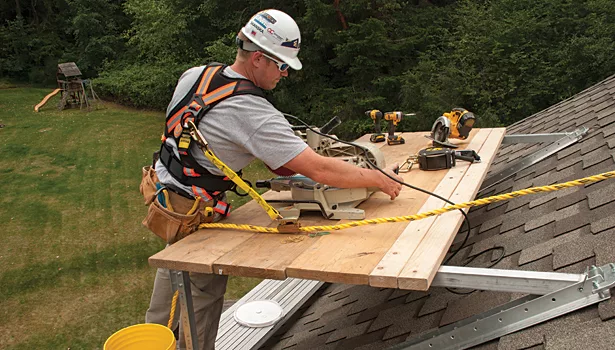
HitchClip anchors are easy to install and use. Once installed, this fall protection anchor can be used for accessories such as the Work Bench and Platform Stage. Photos courtesy of Qualcraft Industries.
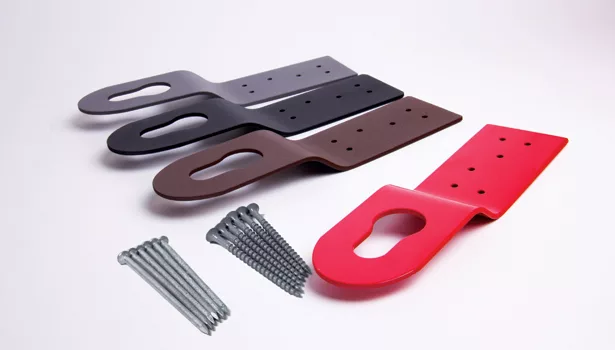
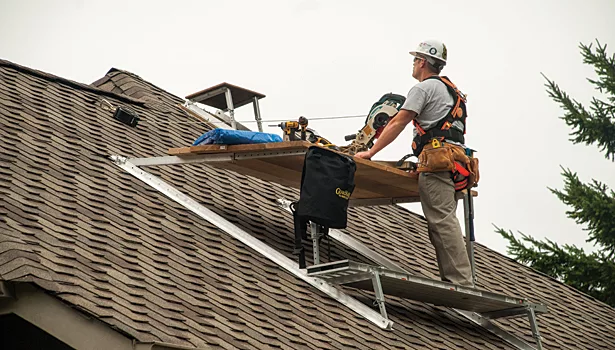
Using eaves-mounted and gable-mounted guardrails may mean no PFAS would be required to be worn within its perimeter after they are installed.
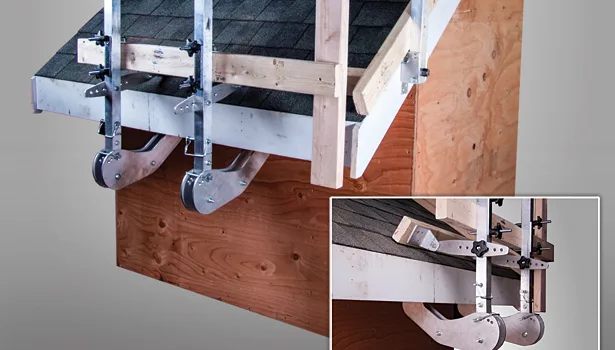
Using eaves-mounted and gable-mounted guardrails may mean no PFAS would be required to be worn within its perimeter after they are installed.
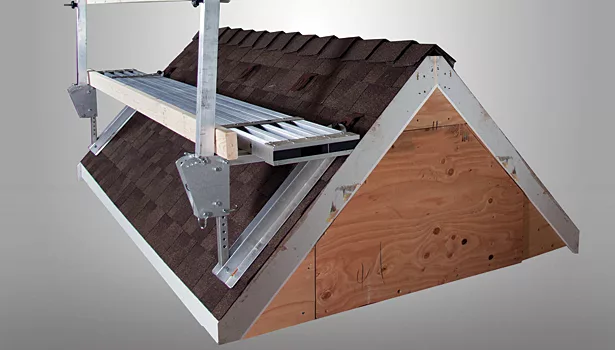
The adjustable Roof Jack (6:12 to 12:12) also accommodates this Mounted Guardrail.
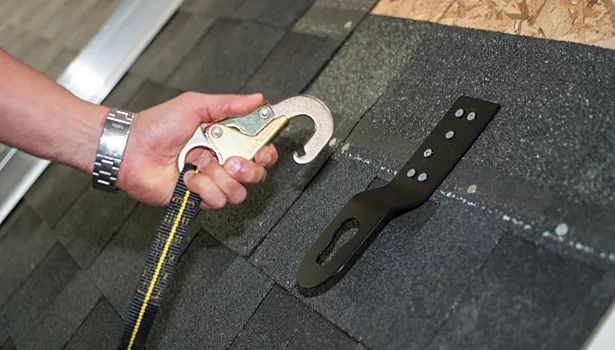
Six nails or screws and 4.4 ounces of aircraftgrade aluminum deliver a 5,000-pound rating.
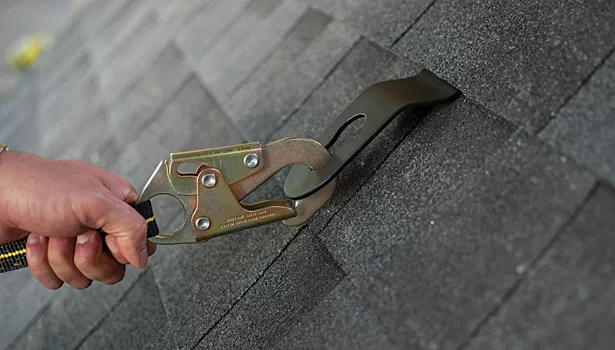
Matching powder coating encourages its use as a permanent anchor. The more visible red anchor is convenient as a temporary anchor.
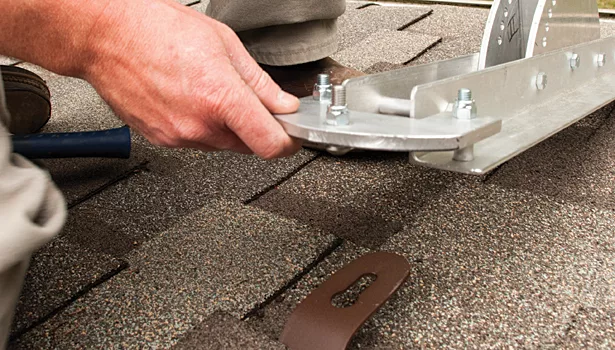
Pictured here is the base of the Free-Standing Guardrail.
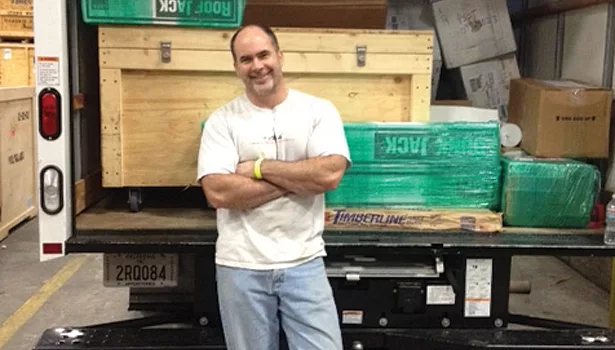
Contractor turned inventor Scott Fontaine says approximately 20 more HitchClip accessories are in the works with Qualcraft Industries.
Ever since it was revised in 1998, roofing contractors have struggled to comply with OSHA’s Subpart M Fall Protection Standard (1926.500). That is because it is very difficult to accomplish — not that it’s unfair. It’s never unfair to expect roofing contractors to protect their workers from fatal falls. But let’s face it — compliant fall protection systems built on and anchored to the very structure you are demolishing or building is the opposite of easy.
The recent 2010 advent of OSHA’s Compliance Guideline for Residential Construction (STD 03-11-002) canceled the previous STD, which allowed specific variances to the regulation. In OSHA’s opinion, the necessary equipment and methods of compliance have become readily available and practical to use in recent years.
The roofing supply and distribution market has always been eager to carry the newest and best fall protection and fall prevention equipment available in their product lines. The difficult issue has always been balancing roofer safety against feasibility, the possibility of creating a greater hazard, and productivity.
When a product or method is developed and reaches the marketplace that solves just one of these problems, we are amazed. When it maintains minimum safety factors, is easy to install and use, is reasonably priced, and saves time and money, we are ecstatic. With this in mind, we gave The HitchClip™ System a test run.
The Key Problems
The multiple safety concerns posed by roofing work are well documented. While the root cause of approximately 35 percent of all construction deaths is falls from heights, more than 30 percent of all fatal falls occurring in residential construction originate from a roof, according to OSHA Fact Sheet DOC-FS 5303, “Reducing Falls During Residential Construction.” This same OSHA document emphasizes the simple necessity for good housekeeping on the roof deck in order to help prevent accidental falls-in-place on the roof: “Workers should be careful of air hoses and power cords for nail guns and other electrical equipment. If a worker steps on one, hoses and cords can slip underfoot and lead to falls.”
Well, the same can certainly be said for the multiple 5/8-inch diameter nylon lifelines rigged from ridge anchors and attached to each roofer’s personal fall arrest system (PFAS). They can also create trip hazards. Therefore, whenever, wherever vertical lifelines (a misnomer, as they actually follow the pitch of the roof deck) are part of your PFAS on a roof, your crews should be well trained in situational awareness and simple rope management skills in order to avoid rope entanglement and falls due to slipping or tripping on the lifelines. Utilizing a 5/8-inch diameter nylon lifeline with a high-visibility marker in one strand of a 12-millimeter kernmantle rope with a bright colored mantle may make the ropes easier to see and avoid on most dark roof surfaces or in low light situations.
OSHA’s Fact Sheet also emphasizes the need for staging tools and material safely on a sloped roof deck to reduce tripping or struck-by hazards: “To minimize exposure to fall hazards, employers can stage materials so that workers on the roof have quick and safe access to them. … Material can also be staged so it cannot slide off the roof edge and potentially strike a worker on the ground.”
A Unique Solution
The HitchClip System is uniquely designed to temporarily attach various accessory components to the permanent anchor using its patented “keyhole connection point” design. These components can combine to create safe material staging areas as well as convenient, stable work stations on the deck instead of the ground. The fewer trips up and down the ladder, the safer it is for everyone.
The HitchClip is an offset, powder-coated (brown, black or grey), 6061 T-6 aluminum anchor. The company also offers a high-visibility red version designed for use as a temporary anchor. If installed according to the manufacturer’s instructions, it provides a minimum 5,000-pound anchorage point for a single worker to tie off a lanyard. It is fastened to a framing member (truss, rafter, or purlin) below the deck by installing six 16D galvanized framing nails or six PrimeGuard #10 21/2-inch exterior screws into the Z-pattern provided on the anchor’s baseplate. The patented “keyhole” punched in the raised section, which rests 1 inch above the roof, easily accepts a standard ANSI double-action safety clip, typically supplied with most fall protection lanyards. This installation provides a temporary or permanent mono-point anchor wherever and whenever desired. These anchor points may also be established at specific distances up a rafter or truss in order for the first roofer on deck to “Tarzan” point-to-point while maintaining 100 percent fall protection by using a double-legged, 3-foot shock-absorbing lanyard to reach the ridge. Here the roofer may install either a large-capacity horizontal lifeline or a number of individual HitchClips for multiple vertical lifelines.
The raised “keyhole” configuration of the HitchClip Anchor is also designed to accept the top-loading, male interlocking pin attached to the bottom face of each of the system’s accessories. Inserted into the top of the keyhole, the pin interlocks as the worker slides it down into the narrow slot below, making a positive gravity lock with the established anchor.
The mandatory daily inspection by the competent person (CP) of the installed anchor as well as any attachment pin and other components on the accessory devices will ensure the connection remains safe and secure while under load. The force required to push the attachment up-slope to disconnect it from the top of the keyhole is considerable (especially when loaded with material or personnel), and it would not go unnoticed by the operator under normal conditions. Should any unintended impact force be accidentally applied to the accessory or the anchor, the CP should immediately inspect the HitchClip System to verify that its integrity and/or stability has not been compromised. If involved, even indirectly, in an accident, the competent person shall immediately inspect the entire system and take any suspect component out of service until (1) its integrity or strength can be confirmed, or (2) it has been replaced by a new component. As the HitchClip anchors have been powder-coated with colors which are designed to blend in with most roofing materials, they could become potential trip hazards if their locations are not readily observed. Special precautions should be taken, if necessary, to mark them temporarily with high-visibility tape or flagging ribbon until the job is complete. Using the red HitchClips in some situations may be advisable.
System Accessories
The Roof Jack: One of the most common uses of the HitchClip System is to establish an anchor point for the adjustable Roof Jacks, the scaffold workhorse of the industry. These practical roofing tools are also constructed from lightweight (6 pound) 6061 aluminum and are fully adjustable from 6:12 to 12:12 pitches. They will accept either aluminum picks or LVL OSHA scaffold planks up to 14 inches wide to provide work staging or debris catching platforms during new or re-roofing projects. Although heavy duty and well constructed, they are still built from aluminum stock and can be easily damaged if dropped from the roof. As with any heavy-duty piece of equipment, proper care and handling during use, transportation and storage will ensure the longevity of the equipment and reduce costly, unnecessary replacements.
The Workbench: The HitchClip Workbench System incorporates two 4-foot-long, adjustable, triangular platform braces bearing on long aluminum base angles. A pair of these workbench brackets can be spaced on rafters below to support a full sheet of plywood or a narrower work platform. Each Workbench System bracket also includes an adjustable roof jack attached down-slope on the base, which is capable of accepting a 10-inch extendable aluminum scaffold pick. This provides a level, stable work area for the worker on sloped roofs up to 12:12 pitch. This Workbench System allows the roofer (or framer) to efficiently use hand and power tools to cut, assemble and store materials in total comfort and safety while 100 percent tied off to an additional HitchClip anchor up-slope. As a former construction estimator, I believe that the efficiency savings in time and money that a roof-mounted cut-and-fab station would provide on a large roof job could easily repay the capital equipment investment quite early in the season.
The Bunk Jack: Similar to the Roof Jack, the Bunk Jack System is an oversized, heavy-duty roofing jack which, when assembled in pairs attached to two HitchClip anchors and staged properly near an eave, can accommodate a full, level bunk of 1/2-inch plyscore (approximately 48 sheets totaling about 2,400 pounds) loaded using an all-terrain telehandler. A set of Bunk Jacks holds 4,000 pounds. It is recommend that crews store only as much material as may be installed in a single shift. It could also be utilized as an adjustable rooftop workbench. An additional pair of roof jacks/HitchClips and scaffold plank would also provide a stable, level platform for the cut-man to stand while ripping plywood sheets. The efficiency of this system is clearly evident whenever you are framing and sheathing a new roof, or building an addition or dormer to an existing roof.
Guardrail Systems: The HitchClip has multiple guardrail systems. The Roof Jack Guardrail mounts quickly and easily to the vertical standard on the HitchClip Roof Jack, which may also hold up to a 14-inch-wide scaffold plank or aluminum pick. The roof jacks (and guardrail posts) may be established 8-10 feet apart. The mounting bracket has pin-locks to adjust the guardrail post plumb on any roof up to a 12:12 pitch. The guardrail posts have U-Bolt brackets designed to secure two-by-four top rails (at 42 inches high) and two-by-four mid-rails (at 21 inches high).
The company offers a Free-Standing Guardrail that mounts directly to the anchor itself for quick and easy setup. HitchClip has also developed an integral rake guardrail system, allowing the entire roof to be protected with engineering controls so that no PFAS would be required to be worn by the roofing crew inside its perimeter.
The Platform Stage: The Platform Stage system incorporates two roof jacks mounted onto a specialized plywood friction base with a 5/8-inch plywood top platform (24 inches by 24 inches) bolted to the horizontal arm of the adjustable bracket, which can accommodate pitches from 6:12 to 12:12. This multi-use Platform Stage may be used with a single HitchClip anchor to support personnel in tight or confined areas, or even stage a ladder base to access a higher roof. The non-slip base for shingle roofs permits the staging to be used without the HitchClip anchor to support tools and equipment only, making them more accessible.
Considering the newly implemented OSHA Guidelines for Residential Fall Protection, it doesn’t take much imagination to see how versatile and adjustable the HitchClip System can be for even the small contractor. The system can be built up slowly over time, and the universality of the HitchClip anchor itself guarantees the system will be useful far into future seasons. The cost of the individual HitchClip anchors permanently installed on your customer’s roofs can be built into the job cost. It might also help to ensure repeat work for future damage repair and roof additions, as the anchors are already in place and ready to use at a moment’s notice. Made in Alabama and Washington state, the hardware is all heavy duty and has a very solid feel. The patented component design was well thought out by its inventor, Scott Fontaine, himself a professional contractor for more than 30 years.
Distributed exclusively by Qualcraft Industries (a division of Guardian Fall Protection), the HitchClip System is available from roofing distributors nationwide and from Qualcraft online at www.qualcraft.com at prices which won’t sink the budget. Demo videos are available at www.hitchclip.com/videos. Although the world has apparently become a less dependable place to live these days, at least tools such as the HitchClip System are helping to make it a more dependable and safe place to work.
Looking for a reprint of this article?
From high-res PDFs to custom plaques, order your copy today!





